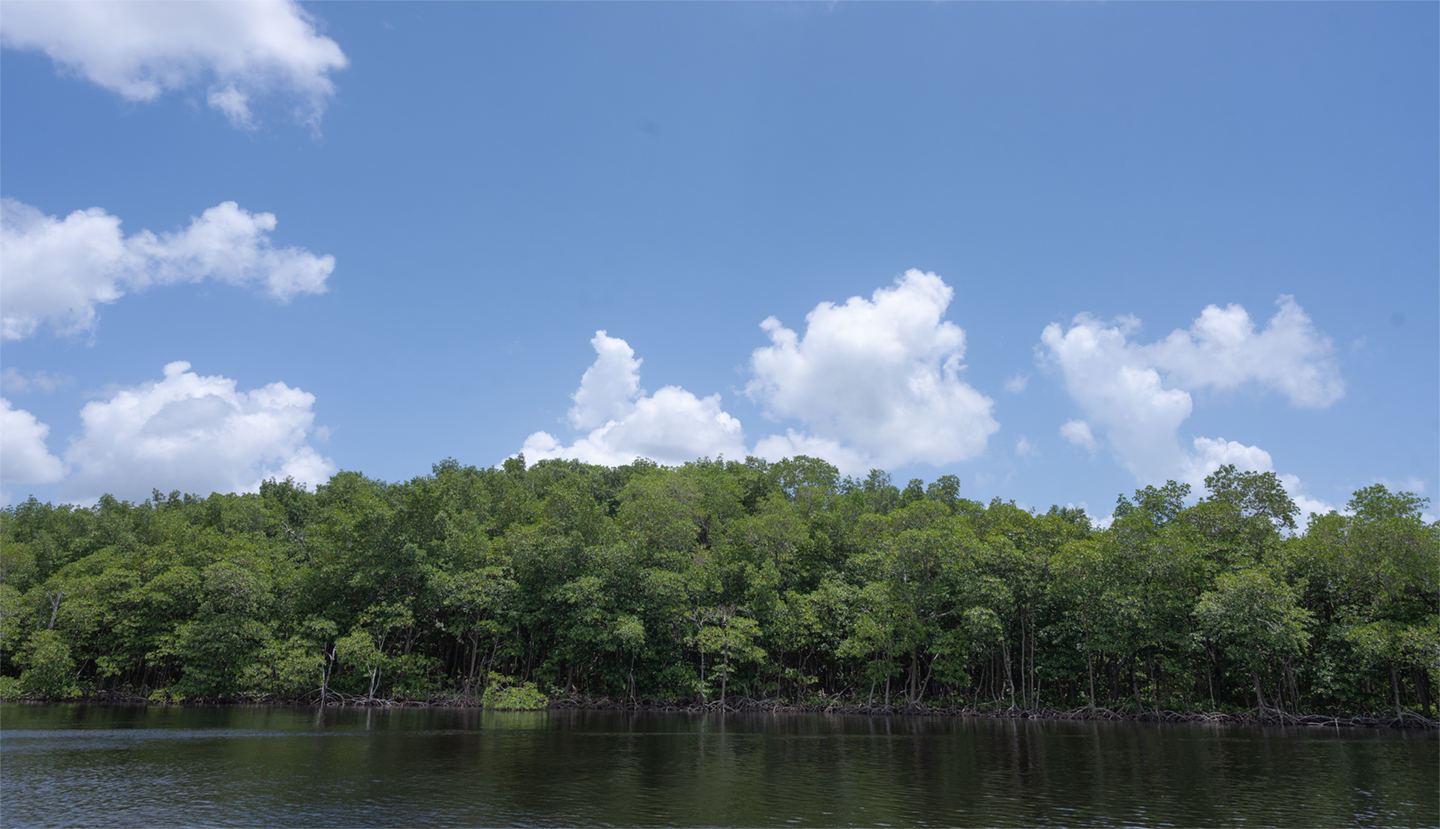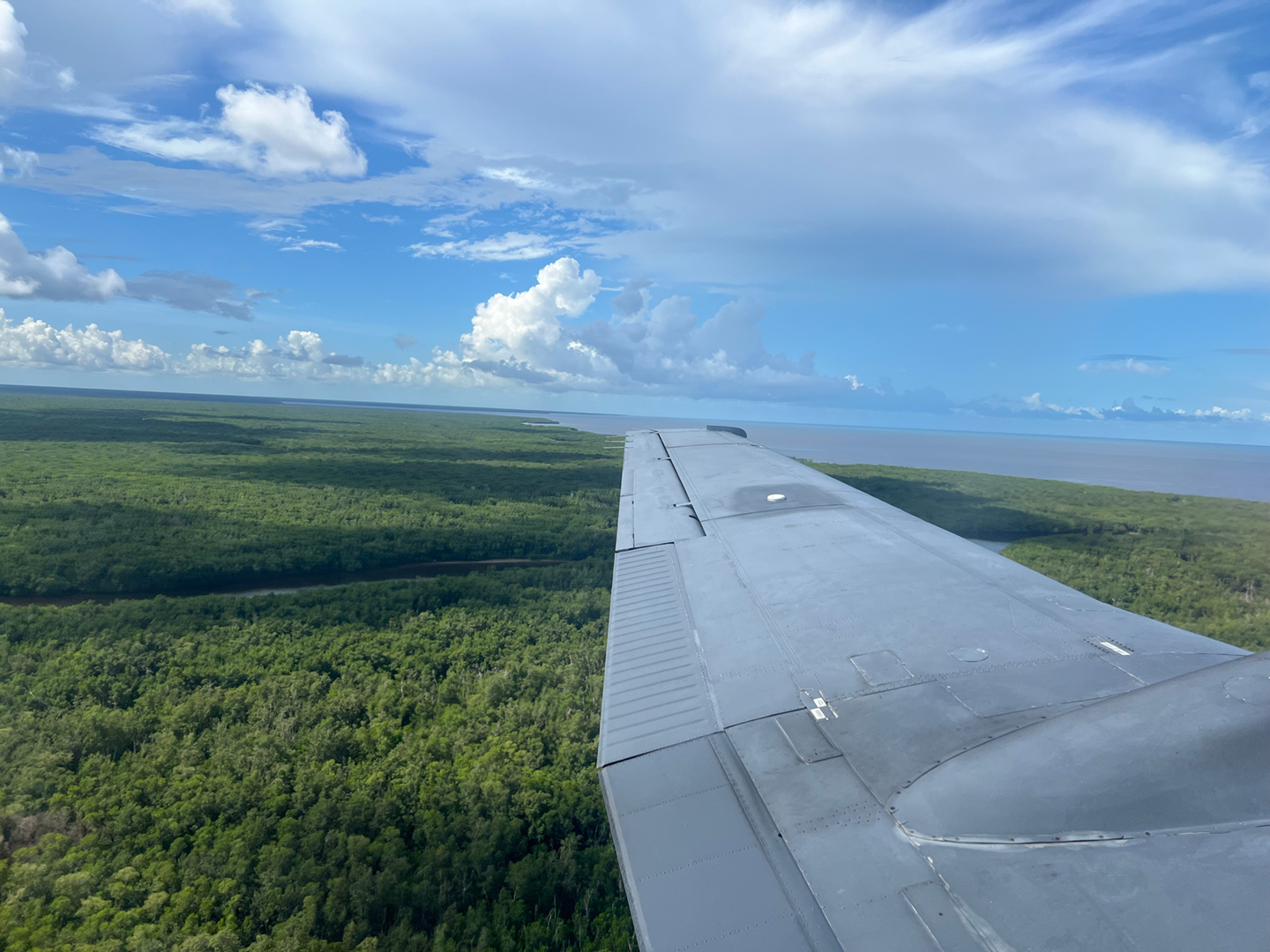Introduction
Along the southernmost rim of the Florida Peninsula, the arching prop roots or “knees” of red mangroves (Rhizophora mangle) line the coast – see Photo 1. Where they dip below the water’s surface, fish lay their eggs, enjoying the protection from predators that the trees provide. Among their branches, wading birds, such as the great blue heron and the roseate spoonbill establish rookeries to rear their young. The tangled matrix of roots collects organic matter and ocean-bound sediments, adding little-by-little to the coastline and shielding inland biology from the erosive force of the sea. In these ways, mangroves are equal parts products and engineers of their environment, but their ecological value extends far beyond this local sphere of influence.
Mangroves are an important carbon dioxide (CO2) sink – responsible for removing CO2 from the atmosphere with impressive efficiency. Current estimates suggest mangroves sequester CO2 10 times faster and store up to 5 times more carbon than rainforests and old-growth forests. But as part of the ever-changing line between land and sea, they’re exceptionally vulnerable to climate disturbances such as sea level rise, hurricanes, and changes in ocean salinity. As these threats intensify, Florida’s sub-tropical wetlands – and their role as a critical sink of CO2 – face an uncertain future.
NASA’s BlueFlux Campaign, a three-year (2021–2024), $1.5-million project operating under the agency’s Carbon Monitoring System, used field, aircraft, and satellite data to study the impact of both natural and anthropogenic pressures on South Florida’s coastal ecology. BlueFlux consists of a series of ground-based and airborne fieldwork campaigns, providing a framework for the development of a satellite-based data product that will estimate daily rates of surface-atmosphere gas transfer or gaseous flux across coastal ecosystems in Florida and the Caribbean. “The goal is to enhance our understanding of how blue-carbon ecosystems fit into the global carbon market,” said Ben Poulter [NASA’s Goddard Space Flight Center (GSFC)—Project Lead]. “BlueFlux will ultimately answer scientific questions and provide policy-related solutions on the role that coastal wetlands play in reducing atmospheric greenhouse gas (GHG) concentrations.”
This article provides an overview of BlueFlux fieldwork operations – see Figure 1 – and outlines how the project might help refine global GHG budgets and support the restoration of Florida’s wetland ecology.

BlueFlux Ground-based Fieldwork
Across the street from the Flamingo Visitors center, at the base of the Everglades National Park, there was once a thriving mangrove population. Now, the skeletal remains of the trees form one of the Everglades’ largest ghost forests – see Photo 2. When Hurricane Irma made landfall in September 2017, violent winds battered the shore and a storm surge swept across the coast, decimating large swaths of the mangrove forest. Most of Florida’s mangroves recovered swiftly. But seven years later, this site and others like it have seen little to no growth.
“At this point, I doubt they’ll ever recover,” said David Lagomasino [East Carolina University].
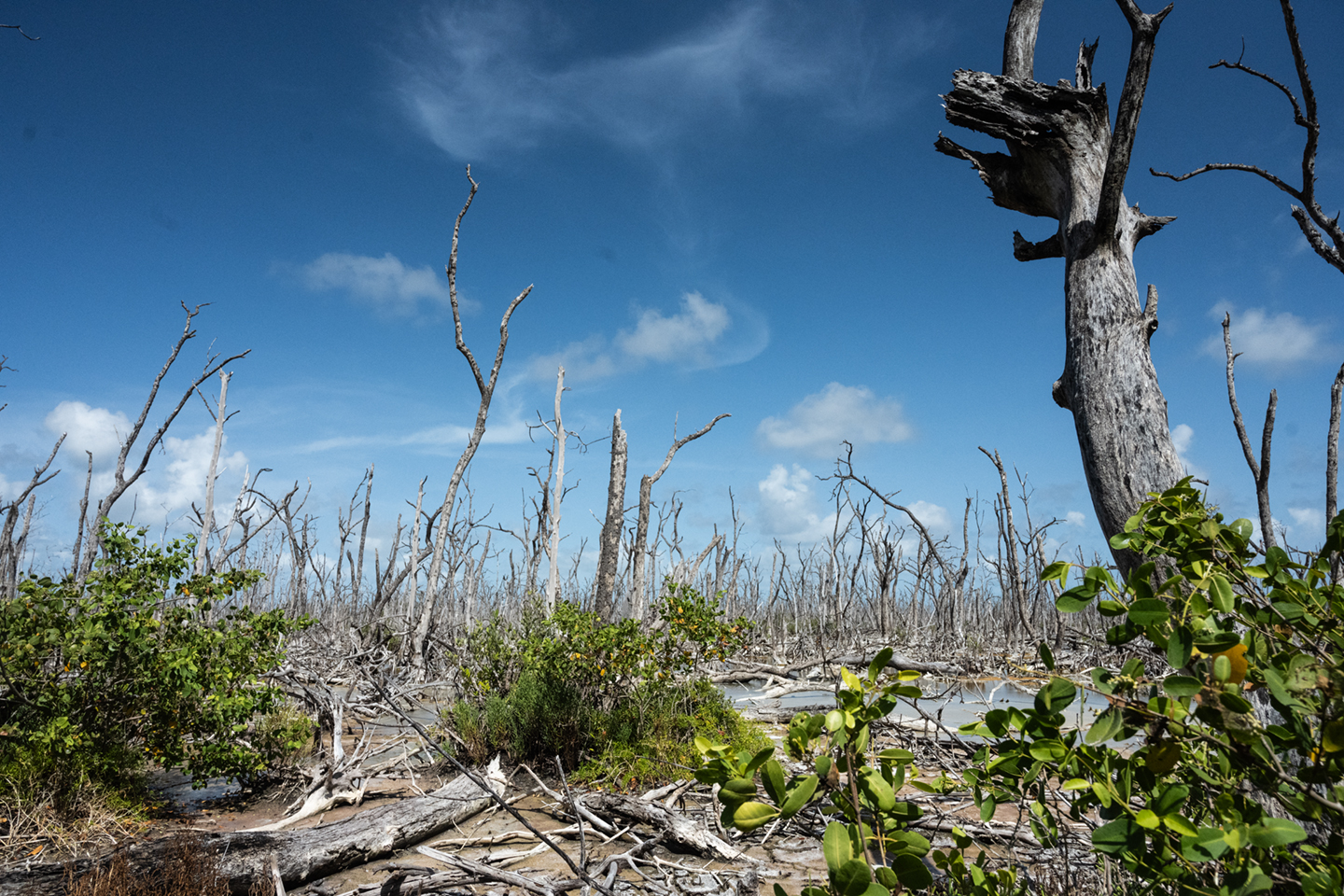
Lagomasino was in the Everglades this summer conducting research as part of the fifth leg of BlueFlux fieldwork – see Photo 3. His team focused on measuring how changes in wetland ecology affect the sequestration and emission rates of both CO2 and methane (CH4). In areas where vegetative health is severely degraded, like in ghost forests, a general decline in CO2 uptake is accompanied by an increase in CH4 production, the net effect of which could dramatically amplify the atmosphere’s ability to trap heat. Ghost forests offer an example at one end of an extreme, but defining the way more subtle gradients among wetland variables – such as changes in water level, tree height, canopy coverage, ocean salinity, or mangrove species distribution – might influence flux is harder to tease out of the limited data available.

In the Everglades, flux measurements are confined to a handful of eddy covariance towers – or flux towers – constructed as part of the National Science Foundation’s (NSF) Long-Term Ecological Research (LTER) Network.
The first flux tower in this network, erected in June 2003, stands near the edge of Shark River at a research site called SRS-6, short for Shark River Slough site 6. A short walk from the riverbank, across a snaking path of rain-weathered, wooden planks, sits a small platform where the flux tower is anchored to the forest floor – see Photo 4. About 20 m (65 feet) above the platform, the tower breaches the canopy, where a suite of instruments continuously measures wind velocity, temperature, humidity, and the vertical movement of trace atmospheric gases, such as water vapor (H2Ov), CO2, and CH4. It’s these measurements collectively that are used to calculate flux.
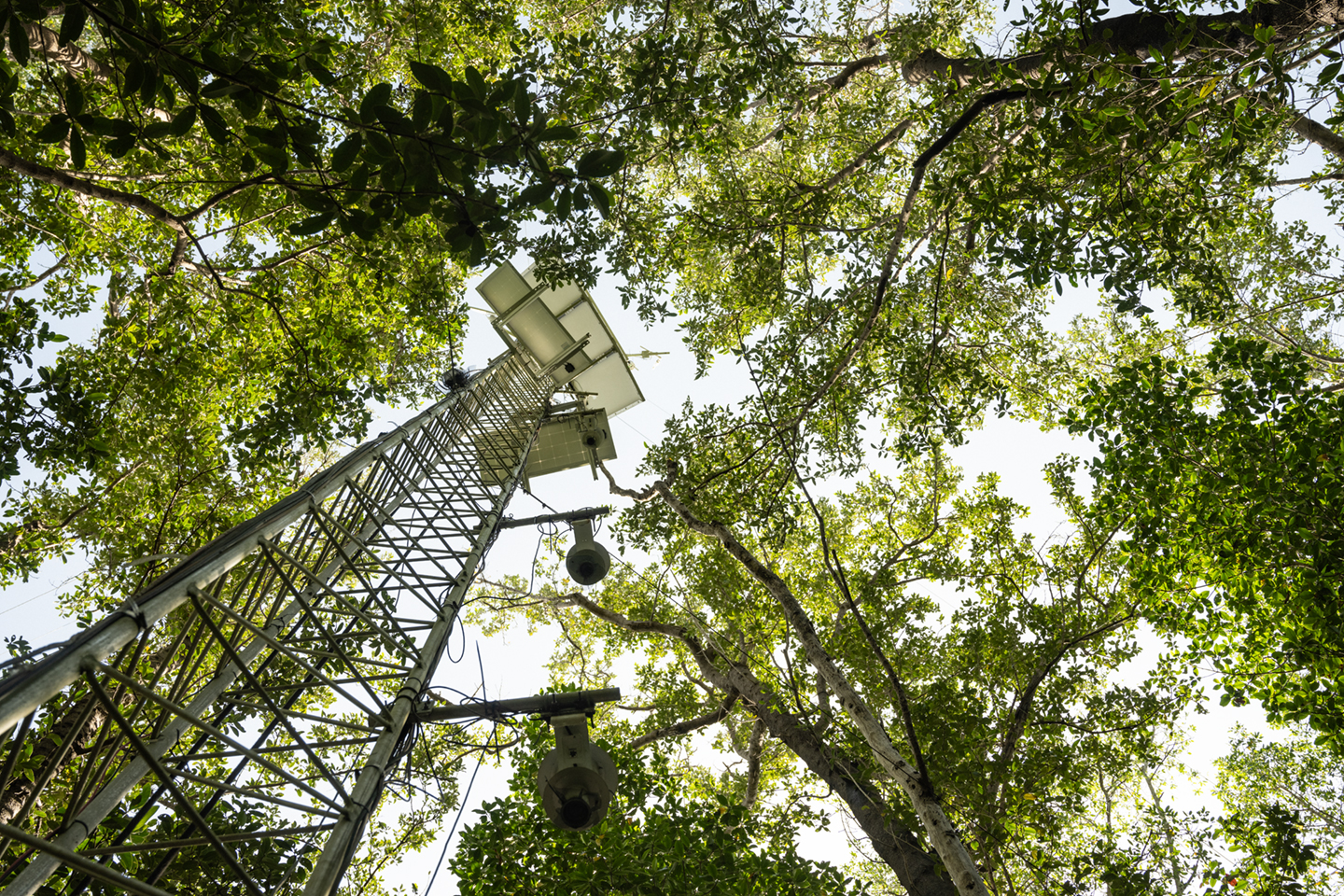
“Hundreds of research papers have come from this site,” said Lagomasino. The abundance of research generated from the data captured at SRS-6 speaks in part to the value of the measurements that the tower makes. It also points to the gaps that exist just beyond each tower’s reach. A significant goal of the BlueFlux campaign is to explain flux on a scale that isn’t covered by existing data – to fill in the gaps between the towers.
One way to do that is by gathering data by hand.
On Lagomasino’s boat is a broad, black case carrying a tool called a Russian peat auger. The instrument is designed to extract core samples from soft soils – see Photo 5.
Everglades peat, which is made almost entirely of the partially decomposed roots, stems, and leaves of the surrounding mangroves, offers a perfect study subject. Each thin, half-cylinder sample gets sealed and shipped back to the lab, where it will be sliced into flat discs. The discs will be analyzed for their age and carbon content by Lagomasino’s team and partners at Yale University. These cores are like biomass time capsules. In Florida’s mangrove forests, a 1-m (3-ft) core might represent more than 300 years of carbon accumulation. On average, a 1 to 3 mm (0.04 to 0.12 in) layer of matter is added to the forest floor each year, building up over time like sand filling an hourglass.

Although coastal wetlands account for less than 2% of the planet’s land-surface area, they house a disproportionate amount of blue carbon – carbon stored in marine and coastal environments. In the Everglades, the source of this immense accumulation of organic material is the quick-growing vegetation – see Photo 6.
When a CO2 molecule finds its way through one of the many small, porous openings on a mangrove leaf – called stomata – its next step is one of creation, where it plays a part in the miraculous transformation of inorganic matter into living tissue. Inside the leaf’s chloroplasts, energy from stored sunlight kickstarts a long chain of chemical reactions that will ultimately divide CO2 into its constituent parts. Oxygen atoms are returned to the atmosphere as the byproduct of photosynthesis, but the carbon stays behind to help build the sugar molecules that will fuel new plant growth. In short, the same carbon that once flowed through the atmosphere defines the molecular structure of all wetland vegetation. When a plant dies or a gust of wind pulls a leaf to the forest floor, this carbon-based matter finds its way into the soil, where it can stay locked in place for thousands of years thanks to a critical wetland ingredient: water.
The inundated, anoxic – an environment deficient or absent of oxygen – peat soils characteristic of wetlands host microbial populations that are uniquely adapted to their environment. In these low- to no-oxygen conditions, the prevailing microbiota consumes organic material slowly, leading to an accumulation of carbon in the soil. As wetland conditions change, the soil’s microbial balance shifts. For example, a decline in water level, which can increase the oxygen-content of the soil, produces conditions favorable to aerobic bacteria. These oxygen-breathing lifeforms consume organic matter far more rapidly than their anaerobic counterparts – and release more CO2 into the atmosphere as a result.
Water level isn’t the only environmental condition that influences rates of carbon sequestration. The soil cores collected during the campaign will be analyzed alongside records of interrelated variables such as water salinity, sea surface height, and temperature to understand not just the timescales associated with blue carbon development in mangrove forests but how and why rates of soil deposition change in response to specific environmental pressures. In many parts of the Everglades, accumulated peat can reach depths of up to 3 m (9.8 feet) – holding thousands of years’ worth of insights that would otherwise be lost to time.

Lola Fatoyinbo [NASA’s Goddard Space Flight Center (GSFC), Biospheric Sciences Lab] and Peter Raymond [Yale University’s School of the Environment] led additional fieldwork teams tasked with collecting forest inventory data in locations where vegetation was dead, regenerating, or recently disturbed by severe weather events. A terrestrial laser system was used to obtain three-dimensional (3D) images of mangrove forest structure, which provided maps of stem density, vertical distributions of biomass, and stand volume surface area. Spectroradiometers were also used to acquire visible, near infrared, and shortwave infrared spectra, delivering detailed information about species composition, vegetative health, water levels, and soil properties.
To tie these variables to flux, the researchers made measurements using chambers – see Figure 2 – designed to adhere neatly to points where significant rates of gas exchange occur, (i.e., mangrove lenticels—cell-sized breathing pores found on tree bark and root systems— and the forest floor). As an example, black mangroves (Avicennia germinans) possess unique aerial roots called pneumatophores that, similar to the prop roots of red mangroves, provide them with access to atmospheric oxygen. Pneumatophores sprout vertically from the forest floor and line up like matchsticks around the base of each tree. The team used cylindrical chambers to measure the transfer of gas between a single pneumatophore and the atmosphere – see Figure 2a.
These observations are archived in NASA's Oak Ridge National Laboratory (ORNL) Distributed Active Archive Center (DAAC) and publicly available to researchers who wish to monitor and identify trends in the data. After nearly three years of field work, these data have already given scientists a more detailed picture of how Florida’s wetlands are responding to environmental pressures.
Research based on data from early BlueFlux fieldwork deployments confirms that aerobic, methanogenic microbes living in flooded, wetland soils naturally release a significant amount of CH4 as a byproduct of the process by which they create their own energy.
“We’re especially interested in this methane part,” said Fatoyinbo. “It’s the least understood, and there’s a lot more of it than we previously thought.” Fatoyinbo also noted a “significant difference in CO2 and CH4 fluxes between healthy mangroves and degraded ones.” In areas where mangrove health is in decline, due to reduced freshwater levels or as the result of damage sustained during severe weather events, “you can end up with more ‘bad’ gases in the atmosphere,” she said. Since CH4 is roughly 80 times more potent than CO2 over 100-year period, these emissions can undermine some of the net benefits that blue carbon ecosystems provide as a sink of atmospheric carbon.
Airborne Research Teams Measure GHG Flux from Above
Florida’s mangrove forests blanket roughly 966 km2 (600 mi2) of coastal terrain. Even with over 20 years of tower data and the extensive measurements from ground-based fieldwork operations, making comprehensive inferences about the entire ecosystem is tenuous work. To provide flux data at scale – and help quantify the atmospheric influence that Florida’s coastal wetlands carry as a whole – NASA’s BlueFlux campaign relies on a relatively new, airborne technique for measuring flux – see Photo 7.
Between 2022 and 2024, over 5 deployments, the team conducted more than 34 carefully planned flights – see Figure 3 – collecting flux data over Florida’s wetlands by plane. Each flight is equipped with a payload known colloquially as “CARAFE,” short for the CARbon Airborne Flux Experiment, which is the airborne campaign’s primary means of data collection. “This is one of the first times an instrument like this has flown over a mangrove forest anywhere in the world,” said Fatoyinbo. “So, it’s really just kind of groundbreaking.”

In the air, GHG concentrations are measured using a well-established technique called cavity ringdown spectroscopy, which involves firing a laser into a small cavity where it will ping back and forth between two highly reflective mirrors. Most gas-phase molecules absorb light at specific wavelengths, depending on their atomic makeup. Since the target molecules in this case are CO2 and CH4, the laser is configured to emit light at a wavelength that only these molecules will absorb. As the laser bounces between the mirrors, a fraction of the light is absorbed by any molecules present in the chamber. The rate of the light’s decay is used to estimate CO2 and CH4 concentrations, generating a time series with continuous readings of gas concentrations, measured in parts per million – see Photo 8. This information is combined with measurements of vertical wind velocity to calculate a corresponding time series of fluxes along the flight track. While these measurements are important on their own, a priority for the airborne team is understanding GHG fluxes in relation to what’s happening on the ground.

Unlike flux towers, which only collect data within a 100 m2 (328 ft2) “footprint,” airborne readings have a footprint that can stretch up to 1 km (0.6 mi) in upwind directions. The plane’s speed, position, and orientation are used to help link flux data to fixed points along the flight’s path – so the team can make comparisons between aerial measurements and those made by the ground-based towers – see Photo 9.
“One challenge with that is the flux towers are much lower to the ground, and their footprint is much smaller,” said Glenn Wolfe [GSFC—BlueFlux Flight Lead]. “So, we have to be really careful with our airborne observations, to make sure they closely resemble our ground-based measurements.”
Part of decoding the airborne data involves overlaying each footprint with detailed maps of different surface properties, such as vegetation cover, soil water depth, or leaf-area index, so the team can constrain the measurements and assign fluxes to specific sources – whether its mangroves, sawgrass, or even water.
Data Upscaling – Making Daily Flux Predictions from Space
The coupling of BlueFlux’s ground-based and airborne data provides the framework for the production of a broader, regional image of GHG flux.
“The eddy flux towers give us information about the temporal variability,” said Cheryl Doughty [GSFC]. “And the airborne campaign gives us this great intermediate dataset that allows us to go from individual trees to a much larger area.”
Doughty is now using BlueFlux data to train a remote-sensing data product, the prototype of which is called Daily Flux Predictions for South Florida. The product’s underlying model relies on machine learning algorithms and an ensemble modeling technique called random forest regression. It will make flux predictions based on surface reflectance data captured by the Moderate Resolution Imaging Spectroradiometer (MODIS), an instrument that flies on NASA’s polar-orbiting Aqua and Terra satellites – see Figure 4.
“We’re really at the mercy of the data that’s out there,” said Doughty. “One of the things we’re trying to produce as part of this project is a daily archive of fluxes, so MODIS is an amazing resource, because it has over 20 years of data at a daily temporal resolution.”
This archival flux data will help researchers explain how fluxes change in relation to processes that are directly described by MODIS surface reflectance data, including sea-level rise, land use, water management, and disturbances from hurricanes and fires.
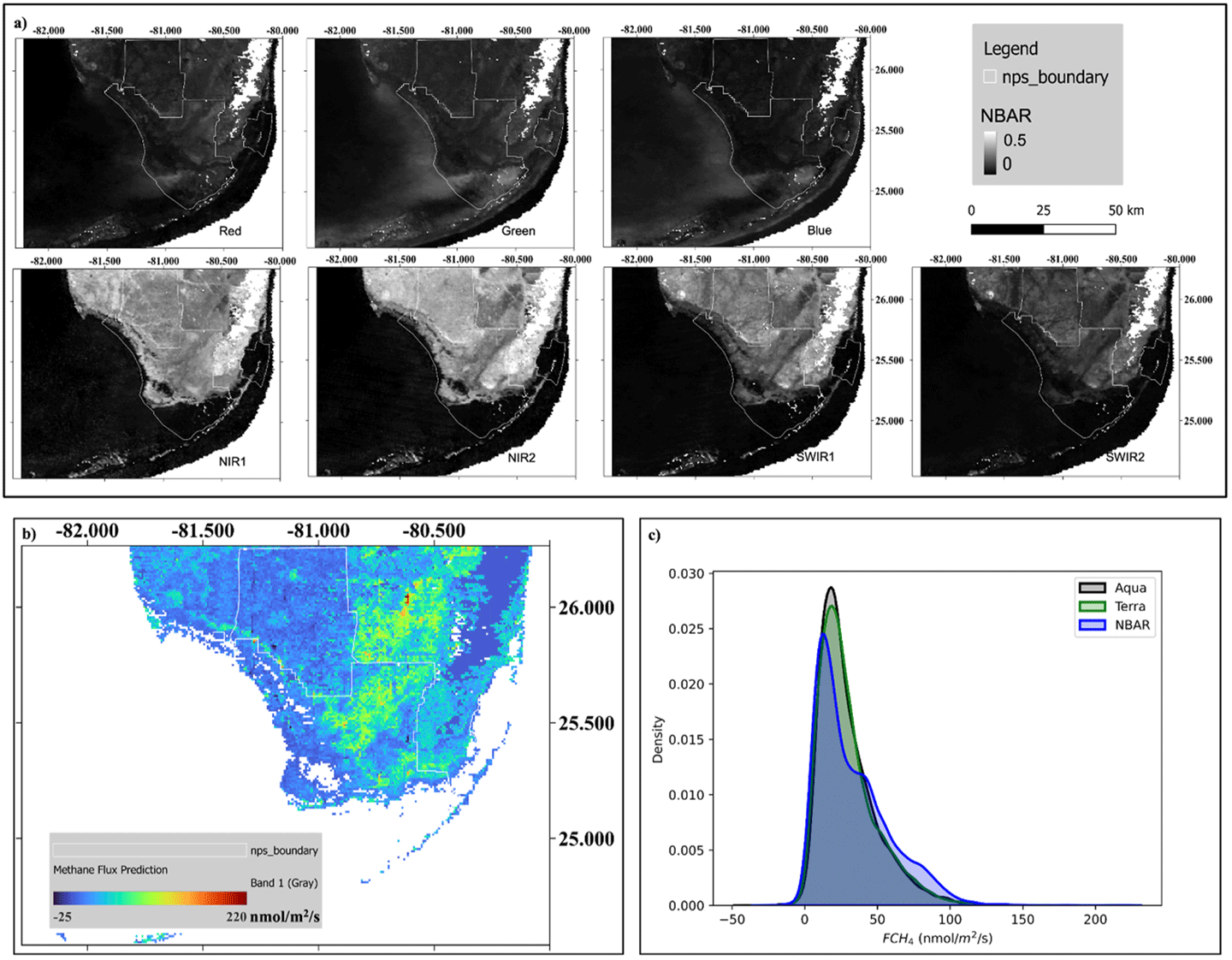
To help validate the model, researchers must reformat flux measurements from the airborne campaign to match the daily temporal resolution and 500m2 (0.3mi2) spatial resolution of MODIS reflectance retrievals.
“It’s best practice to meet the data at the coarsest resolution,” said Doughty. “So, we have to take an average of the hourly estimates to match MODIS’ daily scale.”
The matching process is slightly more complicated for spatial datasets. BlueFlux’s airborne flux measurements produce roughly 20 data points for each 500 m2 (0.3 mi2) area, the same resolution as a single MODIS pixel.
“We're essentially taking an average of all those CARAFE points to get an estimate that corresponds to one pixel,” said Doughty.
This symmetry is critical, allowing the team to test, train, and tune the model using measurements that capture what’s really happening on the ground – ensuring the accuracy of flux measurements generated from satellite data alone.
Researchers don't expect the model to serve as a perfect reconstruction of reality. The heterogenous nature of Florida’s wetland terrain – which consists of a patchwork of sawgrass marshland, mangrove forests, hardwood hammocks, and freshwater swamps – contributes to high degree of variability in CO2 removal rates within and across its distinct regions. The daily flux product accounts for some of this complexity by making hundreds of calculations at a time, each with slightly different parameters based on in-situ measurements.
“The goal isn’t to just give people one flux measurement but an estimate of the uncertainty that is so inherent to these wetlands,” explained Doughty.
The prototype of the product will be operational by early 2025 and accessible to the public through NASA’s ORNL DAAC. Doughty hopes it will help stakeholders and decision makers evaluate policies related to water management, land use, and conservation that might impact critical stocks of blue carbon.
From Drainage to Restoration in the Florida Everglades
In the late 19th century, land developers were drawn to South Florida, where they hoped the fertile soil and tropical climate could support year-round cultivation of commodities such as exotic fruits, vegetables, and sugar cane. There was just one thing standing in the way – the water. If they could find a way to tame Florida’s wilderness, to drain the wetland of its excess water, Florida would offer Americans a new agricultural frontier.
Progress was made incrementally, but the Everglades drainage project idled for more than 50 years as its organizers wrestled with the literal and political morass surrounding South Florida’s wetland topography. It was mother nature’s hand that ultimately accelerated the drainage project. In 1926 and 1928, two large hurricanes tore through the barrier along Lake Okeechobee’s southern shore built to prevent water from spilling onto the newly settled, small-scale farmland just south of the lake. The second of the two storms – 1928’s Okeechobee Hurricane – made landfall in early September and resulted in nearly 3,000 recorded fatalities. In some areas, the torrent of flood water was deep enough that even those who sought refuge from the flood on the roofs of their homes were swept away by the current. The federal government was forced to step in.
By 1938, the U.S. Army Corps of Engineers had completed construction of the Hoover Dike, adding to a collection of four canals responsible for siphoning water away from Lake Okeechobee’s floodplain and into the Atlantic Ocean. Seasonal flooding was brought under control, but the complete reclamation of South Florida’s wetlands proved more challenging than anticipated. As water levels fell and freshly cleared lands dried out, the high organic content of the soil fueled tremendous peat and muck fires that could burn for days, spreading through underground seams where water once flowed. In some areas, fires consumed the entire topsoil layer – exposing the limestone substrata to the atmosphere for the first time in thousands of years. The engineers in charge of Florida’s early wetland reclamation projects underestimated the value of the state’s hydrological system and overestimated its capacity to withstand human interference.
“Those initial four canals were enough to drain the everglades three times over,” said Fred Sklar [South Florida Water Management District—Everglades System Sciences Director]. “And they still exist, but now there are more than seven million people who rely on them for drinking water and flood control.”
Today, much of the Water Management District’s work involves unwinding the damage wrought by earlier drainage efforts.
“One thing we’re trying to do is make sure these peat fires never happen again,” said Sklar.
But restoring natural water flow to the Everglades – which is critical to the region’s ecological health – isn’t an option. Even if drainage could be reversed, it would subject Florida’s residents to the same flood risks that made drainage a priority. Some residents, including members of the Miccosukee and Seminole tribes, live directly alongside or within Everglades wilderness areas, where the risk of flooding is even greater than it is in the state’s highly populated coastal communities. These areas are also out of reach of the Water Management District’s existing infrastructure. It’s not as simple as turning the tap on and off.

Florida’s Water Management District works with federal agencies, including the U.S. Army Corps of Engineers, to monitor and govern the flow of Florida’s freshwater. The District has overseen the construction and management of dozens of canals, dikes, levees, dredges, and pumps over the last half-century that offer a higher degree of control over Florida’s complex hydrological network – see Photo 10.
“The goal is to restore as much acreage as we can, but we also need to restore it functionally, without degrading the whole system or putting residents at risk,” summarized Sklar. “To do this effectively, we need a detailed understanding of how the hydrology functions and how it influences all of these other systems, such as carbon sequestration.”
Since the 1920s, more than half of Florida’s original wetland coverage has been lost. The present system also carries 65% less peat coverage and 77% less stored carbon than it did prior to drainage. As atmospheric CO2 concentrations climb at unprecedented rates, an accompanying rise in sea levels, severe weather, and ocean salinity all present serious threats to Florida’s wetland ecology – see Figure 5.
“We’re worried about losing that stored carbon,” said Poulter. “But blue carbon also offers tremendous opportunities for climate mitigation if conservation and restoration are properly supported by science.”

Conclusion – The Future of Flux
Every few years, the Intergovernmental Panel on Climate Change (IPCC) releases emissions data and budget reports that have important policy implications related to the Paris Agreement’s goal of limiting global warming to between 1.5°C (2.7°F) and 2°C (3.6°F) compared to pre-industrial levels. Refining the accuracy of global carbon budgets is paramount to reaching that goal, and wetland ecosystems – which have been historically under-represented in climate research – are an important part of the equation.
Early estimates based on BlueFlux fieldwork deployments and upscaled using MODIS surface reflectance data suggest that wetland CH4 emissions in South Florida offset CO2 removal in the region by about 5% based on a 100-year CH4 warming potential, resulting in a net annual CO2 removal of 31.8 Tg (31.8 million metric tons) per year. This is a small fraction of total CO2 emissions in the U.S. and an even smaller fraction of global emissions. In 2023, an estimated 34,800 Tg (34.8 billion metric tons) of CO2 were released into the atmosphere. But relative to their size, the CO2 removal services provided by tropical wetlands are hardly dismissible.
“We’re finding that massive amounts of CO2 are removed and substantial amounts of CH4 are produced, but overall, these ecosystems provide a net climate benefit by removing more greenhouse gases than they produce,” Poulter said.
Access to a daily satellite data product also provides researchers with the means to make more regular adjustments to budgets based on how Florida’s mutable landscape is responding to climate disturbances and restoration efforts in real time.
With the right resources in hand, the scientists who dedicate their careers to understanding and restoring South Florida’s ecology share a hopeful outlook.
“Nature and people can absolutely coexist,” said Meenakshi Chabba [The Everglades Foundation—Ecologist and Resilience Scientist]. “But what we need is good science and good management to reach that goal.”
The Everglades Foundation provides scientific evaluation and guidance to the elected officials and governmental institutions responsible for the implementation of the Comprehensive Everglades Restoration Plan (CERP), a federal program approved by Congress in 2000 that outlines a 30-year plan to restore Florida’s wetland ecology. The Foundation sees NASA’s BlueFlux campaign as an important accompaniment to that goal.
“The [Daily Flux Predictions for South Florida] data product is incredibly valuable, because it provides us with an indicator of the health of the whole system,” said Steve Davis [The Everglades Foundation—Chief Science Officer]. “We know how valuable the wetlands are, but we need this reliable science from NASA and the BlueFlux Campaign to help translate those benefits into something we can use to reach people as well as policymakers.”
Researchers hope the product can inform decisions about the management of Florida’s wetlands, the preservation of which is not only a necessity but – to many – a responsibility.
“These impacts are of our own doing,” added Chabba. “So, now it’s incumbent upon us to make these changes and correct the mistakes of the past.”
Next, the BlueFlux team is shifting their focus to what they call BlueFlux 2. This stage of the project centers around further analysis of the data collected during fieldwork campaigns and outlines the deployment of the beta version of Daily BlueFlux Predictions for South Florida, which will help generate a more accurate evaluation of flux for the many wetland ecosystems that exist beyond Florida’s borders.
“We’re trying to contribute to a better understanding of global carbon markets and inspire further and more ambitious investments in these critical stocks of blue carbon,” said Poulter. “First, we want to scale this work to the Caribbean, where we have these great maps of mangrove distribution but limited data on flux.”
An additional BlueFlux fieldwork deployment is slated for 2026, with plans to make flux measurements above sites targeted by the state for upcoming restoration initiatives, such as the Everglades Agricultural Area Environmental Protection District. In the Agricultural Area, construction is underway on a series of reservoirs that will store excess water during wet seasons and provide a reserve source of water for wildlife and residents during dry seasons. As the landscape evolves, BlueFlux will help local officials evaluate how Florida’s wetlands are responding to efforts designed to protect the state’s most precious natural resource – and all those who depend on it.
Nathan Marder
NASA’s Goddard Space Flight Center/Global Science and Technology Inc.
nathan.marder@nasa.gov


























